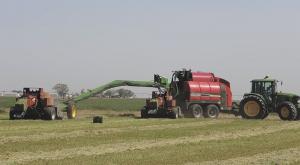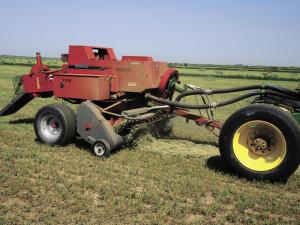2013 - Volume #37, Issue #5, Page #13
[ Sample Stories From This Issue | List of All Stories In This Issue | Print this story
]
Double Hitch Pulls Small Balers Behind Dew Simulator
 |
 |
Normally, a big square baler is pulled behind the DewPoint, but Guy Carthel, Lockney, Texas, sells small square bales to the horse market. His hitch measures 46 ft. long and consists of a 4 by 12-in., 3/8-in. thick steel tube with a 2-wheeled steerable axle on back. One baler hooks up directly to the DewPoint machine, and the other attaches to the 2-wheeled axle. The front end of the hitch swivels from side to side on a gooseneck ball attached to the DewPoint machine. A big double piston pump mounts on back of the DewPoint and is used to operate hydraulic motors that drive each baler. A pair of big hoses lead back to each baler to deliver steam that moistens the hay.
“I built it last winter and couldn’t be happier with it,” says Carthel. “I like the idea behind the DewPoint, but it wouldn’t have paid to pull a single small square baler behind it. This hitch lets me use the full capacity of the machine.”
The DewPoint Simulator is used in arid regions of the western U.S. where growers have to wait – sometimes for days – for natural dew to form before they can start baling. The “dew simulator” machine solves that problem by applying steam to hay as it’s being baled.
The self-contained steam generating machine hooks up between the tractor and baler. A pto shaft and hydraulic lines run through the rig back to the baler.
The machine is equipped with a boiler and 6 water tanks totaling 1,000 gal., as well as two 150-gal. diesel tanks (to fire the boiler burner) and a diesel-powered electrical generator to power the boiler’s electrical system. Steam delivery hoses extend from the boiler back to the baler.
Injection manifolds mounted above and below the baler’s pickup assembly apply steam to the hay, softening it up to prevent leaf loss and shattering during movement into the baler. Additional steam is injected into hay as it passes through the feed chamber and just before it’s compressed in the bale chamber. An electronic moisture sensor mounted in the bale chamber reads the bale’s moisture level and displays it on a moisture meter inside the tractor cab. The operator can adjust moisture level on-the-go from the cab.
“Together with the cost of the hitch I’ve got about $200,000 invested in this system. But when I look at all the economics, it saves me money,” says Carthel. “I can bale high quality hay with just the right moisture up to 24 hours per day. Consistency in feed quality and bale conformation is extremely important to the horse market, and with the DewPoint I can deliver high quality hay.
“With my 2-baler hitch one man with 2 balers can make 4,000 to 5,000 bales per day, whereas without the DewPoint two operators were lucky to make 2,500 bales in one night. And there was always a lot of downtime waiting for the hay to get humid enough to bale. Now I can bale hay any time, and being able to do that reliably is an amazing thing. It lets me get more done with less equipment and fewer people and improves my business outlook tremendously.”
The tube hitch bar serves as an oil reservoir and holds 58 gal. of oil. Another 20-gal. tank mounts on top of the hitch.
“I can swing the back baler 29 ft. in either direction from the centerline of the tractor. The back part of the hitch pivots on a 5th wheel-type setup, so that the axle always stays inline,” notes Carthel.
Contact: FARM SHOW Followup, Guy Carthel, 1040 Co. Rd. 77, Lockney, Texas 79241 (ph 806 292-1602; guy@carthelfarms.com; www. staheliwest.com.)

Click here to download page story appeared in.
To read the rest of this story, download this issue below or click here to register with your account number.




